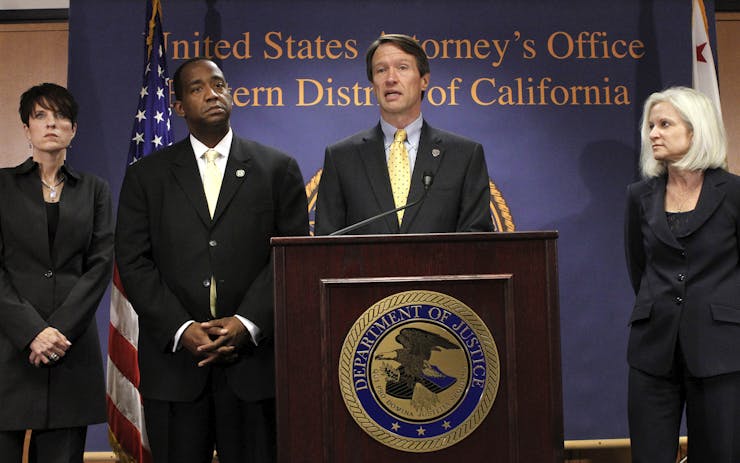Attorney General Jeff Sessions’ desire to slow or stop America’s experiment with marijuana legalization was obvious well before he gave the nod to federal prosecutors to go after state-legal cannabis. But his latest move, rescinding the Cole memo, has triggered speculation over what a Trump administration crackdown would look like.
Recent history might help answer that question. Crackdowns have happened before—and more recently than most people remember. Although they failed to permanently hobble the cannabis industry, enforcement actions from 2011 to 2013 offer examples of what a federal crackdown might look like.
One big lesson: Enforcement doesn’t always involve door-busting, SWAT-style raids. In the last major crackdown in California, the feds simply snuck in through the mailbox.
Back in September 2011, California’s medical dispensaries were booming when a number of commercial property owners began to receive foreboding letters. The envelopes were thin, containing just a few sheets of paper, but there was cause for concern well before the first seal was broken: The envelopes bore the return address of the local United States attorney.
Nearly all the recipients were landlords who leased space to medical marijuana dispensaries, which in the years prior had popped up en masse across most of the state. Though many of the property owners had never so much as touched cannabis, they found themselves the target of the biggest attack on America’s marijuana legalization movement in years.
If it was meant to halt the legalization movement’s growing momentum, the crackdown backfired.
The landlords were given a choice: Either kick out their dispensary tenants or risk losing everything. Those who didn’t evict cannabis operators, the letters warned, could see their properties and other assets seized, and be sentenced to up to 40 years in prison.
It was an innovative strategy. And for a while, it worked.
Each US attorney took a different approach, but each saw success. Across California, hundreds of dispensaries closed. In some parts of the state, legal marijuana storefronts vanished entirely. Intimidated elected officials took a step back. Medical marijuana regulatory programs were canceled, and an ambitious plan to unionize the cannabis industry screeched to a halt. Patients protested. Prohibitionists cheered.
But the great California cannabis crackdown didn’t last. Dispensaries disappeared only to re-emerge as clandestine delivery services. The state’s oldest and largest dispensaries, such as Oakland’s Harborside Health Center, challenged the feds in court—and won. In the middle of it all, voters in Colorado and Washington legalized cannabis for all adults, drawing the Justice Department’s attention away from California.
If it was meant to halt the legalization movement’s growing momentum, the crackdown backfired.
Less than a year later, in August 2013, Deputy Attorney General James Cole issued guidance to US attorneys across the country. In a nonbinding memo, prosecutors were advised not to interfere in state-legal cannabis programs unless they ran into specific problems, such as diversion out of state, violence, or sales to minors. The document, which became known as the Cole memo, effectively de-prioritized federal cannabis enforcement in legal states.
By that time, the California asset forfeiture letters had stopped coming. In 2016, with full legalization on the ballot in California, more than a few cannabis advocates and entrepreneurs celebrated a triumph.
Then came Election Day, which ended with both an exclamation point and a question mark. Passing Prop. 64 made California the largest legal-cannabis state in the nation, but electing Donald Trump—whose views on cannabis seemed friendly but were largely unknown—caught the industry off guard.
Shop highly rated dispensaries near you
Showing you dispensaries nearCautious optimism dissolved later that month, when Trump tapped then-Sen. Jeff Sessions as US attorney general. For legal cannabis, the selection of Sessions—who once rejected by his peers for a federal judgeship after joking that Ku Klux Klan members were “OK, until I found out they smoked pot”—was a worst-case scenario.
Since taking office, Sessions has steadily stoked more fears, openly deriding data that suggest cannabis could help ease the opioid crisis and declaring marijuana “only slightly less awful” than heroin.
For the first year, Sessions’ attacks came in speeches or offhand remarks. Then, on Jan. 4, he finally took action, rescinding the Cole memo and returning the nation—or the Justice Department, at least—back to its 2012 stance on cannabis.
It’s now up to the state’s four federal prosecutors to decide whether to pursue California cannabis businesses. If they do, they’ll be bound by the same constraints that faced the last crackdown: competing policy priorities, a limited budget, and overstretched prosecutors.
Meanwhile, the cannabis movement is larger, better funded, and more politically popular than ever. Many entrepreneurs say the opportunity for the Justice Department to stop legalization has come and gone. The DEA has only about 4,000 agents worldwide, and most US attorneys’ offices have relatively small staffs. It’s unlikely such a force could dismantle California’s industry, let alone the thriving cannabis sectors in multiple other states.
Sessions has heard all this before. He does not appear to care. The Trump administration has demonstrated a willingness to punish state and local officials who defy the White House’s agenda, and representatives from legal-cannabis states such as California and Washington have frequently been a thorn in the president’s side.
As the 2011-2013 California crackdown showed, even if the feds don’t have the army of agents necessary to wage an all-out drug war, they can still do significant damage to business plans, public opinion, and lawmakers’ attitudes with little more than lawyers and letterhead.
Within a year of the first letters, “hundreds” of dispensaries throughout the state had closed. There were no official tallies, but according to California NORML, thousands of legal jobs were lost, and tens of millions in local and state tax revenue disappeared with them.
Yet from the beginning, the crackdown was both erratic and arbitrary.
It wasn’t always clear who was being targeted—or why. In San Francisco, according to then-US Attorney Melinda Haag of the Northern District, only dispensaries within 1,000 feet of a park or a school—the circumference inside which drug dealing triggered stiff mandatory minimums—were targeted. But it soon became clear that protecting children wasn’t the only criterion.
Several first-generation dispensaries—known for “compassionate” programs that supported patients who were low-income, disabled, or veterans—got the axe. Meanwhile, slick newcomers who landed gushing writeups in the New York Times’ style section went untouched.
In the city’s notorious Tenderloin, tiny dispensaries shut down while street dealers up the street sold prescription pain pills, heroin, and methamphetamines unmolested.
Across the bay, in Berkeley, where Haag and her family lived, only one of the city’s three dispensaries received a letter. (It was chosen, rumor had it, because Haag drove past it on her commute to and from work.)
Laura Duffy, then the US attorney for California’s Southern District, went as far as to threaten jail time for newspapers and other media personnel who ran cannabis-related advertisements. No outlets were ever prosecuted, but many advertisers scuttled contracts that helped keep media in business.
In a Sessions-led crackdown, the uneven approach to enforcement is likely to return. Absent a directive from Washington, DC, and the resources to accomplish it, each US attorney will be responsible for taking action—or not.
Some US attorneys named by Sessions to succeed Obama-era appointees have already aired their anti-cannabis views. McGregor Scott, Sessions’ new man in Sacramento, earned a reputation for pursuing harsh sentences against marijuana operators in the state’s cannabis-saturated Eastern District. Luke Scarmazzo, a Modesto man sentenced to prison for 20 years under a statute designed to pursue hardened drug-cartel capos, was put behind bars by Scott (and denied clemency by Obama).
Rural areas under Scott’s watch, such as Nevada County, where sheriff’s deputies are raiding bigger and bigger marijuana plantings, seem the likeliest locations for federal activity. As with the last crackdown, US attorneys are likely to select symbolic targets meant to maximize deterrence.
Any federal enforcement actions against legal cannabis is likely to be not only a battle of strength but also one of endurance. While federal prosecutors found early success threatening asset forfeiture in 2011, over time they began to lose ground.
Major dispensaries such as Harborside, Berkeley Patients Group, and Shambhala Healing Center challenged eviction proceedings filed by their landlords and received state judges’ blessing to stay. They weren’t violating the terms of their leases, the reasoning went, so there was no cause to remove them.
When the Justice Department responded by filing asset forfeiture proceedings, those also failed. In Shambhala’s case, the dispensary’s landlord managed to settle its case for $150,000 after a state judge nullified the eviction notice. By 2013, Harborside—still in business and with its own asset forfeiture proceeding locked up in pretrial motions—felt confident enough to commission a short video mocking Haag in caricature.
Pushback had also grown in the form of public protests. In the Northern District, activists were harrying Haag so much that she began to cancel public appearances.
The crackdown was losing steam—and fast. But it would take three more years and Congress’s passage of a budget amendment (the Rohrabacher-Farr amendment, now known as Rohrabacher-Blumenauer) forbidding the DOJ funding from pursuing state-legal cannabis for the feds to finally—if not publicly—admit defeat.
By then, California’s legalization measure, Prop. 64, had already earned endorsements from high-wattage politicians like Gavin Newsom and millions of dollars in funding from politically prestigious bankrollers like tech billionaire Sean Parker. The country had shifted to a “new model” to address marijuana, Stanford University law professor Robert MacCoun told the San Francisco Chronicle in May 2016.
In the Sessions era, the “new model” includes broad support from conservative lawmakers. Florida U.S. Rep. Matt Gaetz, who represents one of the most reliably conservative districts in the country, joined U.S. Sen. Cory Gardner (R-Colorado) in criticizing Sessions from the right. Gardner went as far as to threaten to hold up future judicial nominees in committee unless Sessions relented.
So far, Sessions’ move to pull the Cole memo has had only psychological impact—and not all of it negative. In the days after the memo was yanked Jan. 4, the Vermont legislature voted to legalized small amounts of marijuana for adults. While that bill does not include a legal commercial marketplace, if signed by Gov. Phil Scott, it would be the first time legalization came by the lawmaking process rather than ballot initiative.
Meanwhile, in New Jersey, Gov. Phil Murphy has promised to follow through with a campaign vow to legalize recreational cannabis within 100 days; and in New Hampshire, an adult-use legalization bill has already passed the state House.
It’s much, much too late to stop marijuana legalization. If Sessions’ goal is to slow it, he must act soon. If he does, we could be in for a repeat of the 2011-2013 era. And that did not end well for the feds.





